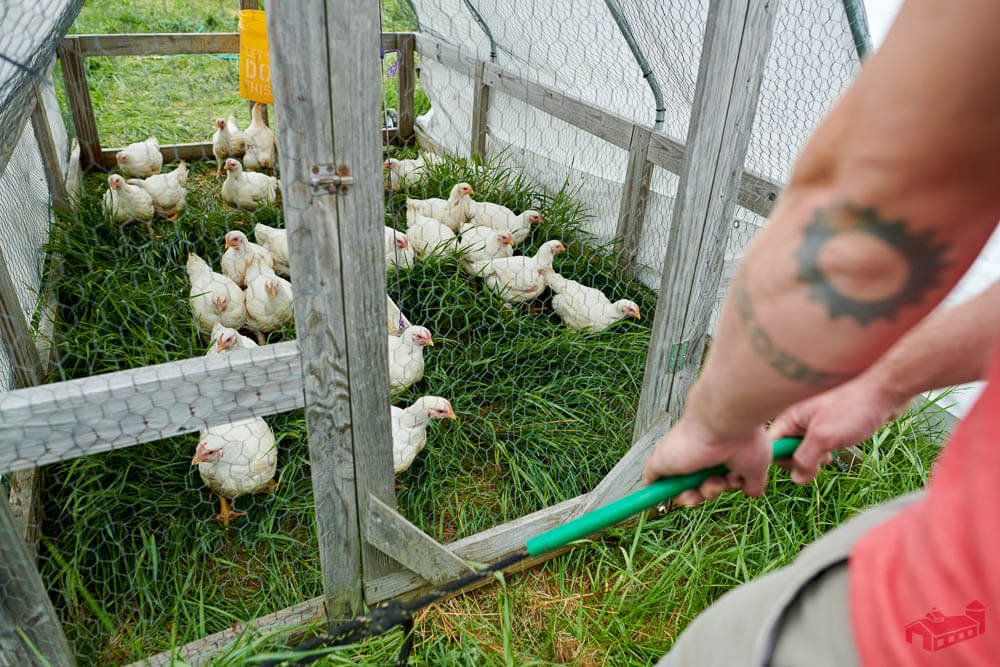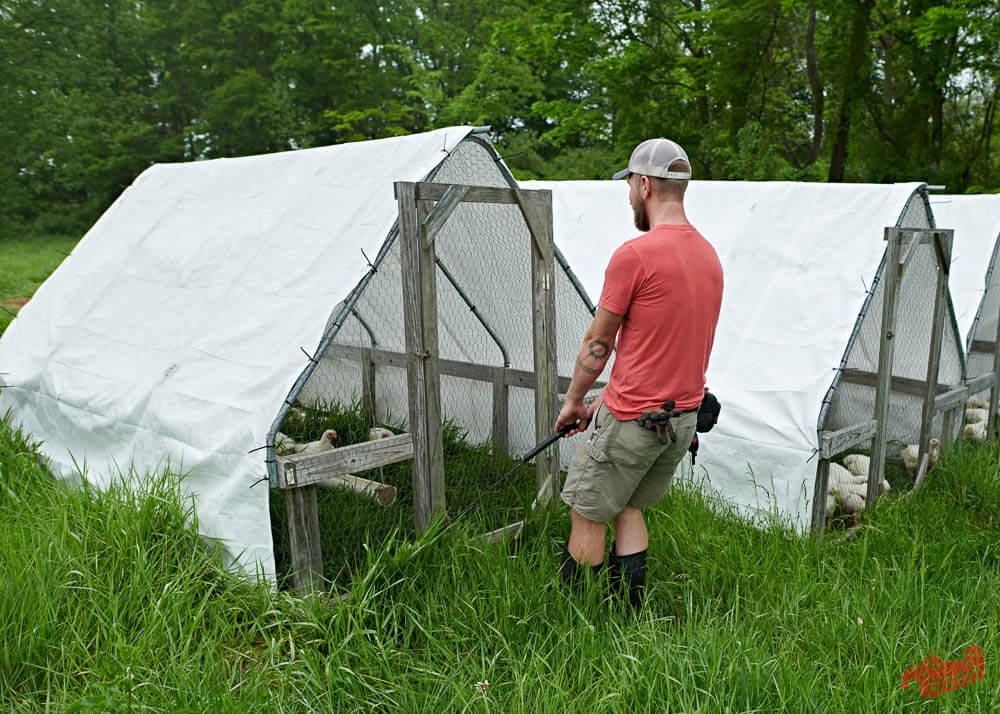6 things you NEED to raise broiler chickens on PASTURE
/Simply put, if you are looking to grow the most delicious meat chicken you are going to have to raise them on pasture (grass) with regular movement. Those two things will add value to your birds that your family your customers will appreciate. It also provides better quality of life for you the farmer, and for your chickens.
But what do you need in order to raise broiler chickens out on grass? We are going to discuss the six easy, but critical items for successful pastured poultry. The first five are going to seem obvious, but the sixth one is going to blow your mind!
Space
Shelter
Feed
Water
Data
SECRET WEAPON!!!
I’ll give you a teaser on #6. It makes my birds grow faster, it helps them use less feed, and it cut out a whole week of labor.
#1 Space - Raising Chickens Outside
You need less lawn space than you think to raise enough chicken to last a year for your entire family. Yes, I said lawn. You can do this in your back yard, or in a farm field. It all depends on what your goals are, and your available resources.
These chicken tractors pictured above are made to hold 30 birds at a time. They are 6’x10’ which gives roughly 2ft-squared per bird. They get moved once a day for the 28-32 days that the chickens are out on pasture. Remember, they start in the brooder.
That means 60 square feet x 30 moves = 1,800 total square feet.
For perspective, a baseball diamond (just infield) is 90’x90’ = 8,100square feet. You could raise 4.5 batches of chickens and never hit the same ground twice.
#2 Pasture Shelter - Protection from Weather & Predators
One hard fact about poultry farming is that EVERYTHING eats chicken. Hawks, coyotes, raccoons, bobcat, me, the neighbor’s dogs. Once you start to raise chickens you are going to have to keep them safe.
Chickens also need protection from the weather. They evolved from jungle fowl, living on the edge of fields, with trees and shrubs for cover. So, let’s mimic that while keeping them comfortable and productive.
This is what it looks like over my shoulder on a daily move along pasture. The birds know it is time for a fresh salad bar, and they walk right along with the shelter.
Here we can see that they are in a floor-less shelter, with wire and a tarp covering the the sides and top. The tarp keeps the rain and sun out, the wire helps protect from predators, and the open ends allow for airflow.
The key to a successful pasture shelter is mobility. It has to be light enough to move by yourself, but heavy enough to stand up to storm conditions. The chicken tractors that I designed do both, and also allow you to walk in and work with your flock.
Everything mentioned on this post (and much more) can be found in my books about raising and selling chickens for meat and eggs. I am proud that my publications have been sold all over the world, and have helped many farmers and homesteaders add pastured poultry to their agricultural adventures!
You can find all three in my store by clicking the button below.
#3 Feed - Poultry Nutrition
If you are what you eat, you are what you eat - eats! 90% of the issues you may face as a poultry farmer are going to come from the chickens’ diet. Sourcing high-quality fresh feed is absolutely essential for the health of your flock. Chickens CANNOT live on grass and bugs alone.
I feed a certified organic broiler feed from a local feed mill. Using a local mill ensures that I am getting freshly mixed feed, and that there is accountability if something goes wrong.
You want to keep feed in a location where it will remain dry. If you let your feed get wet it can develop molds and mycotoxins that can slow the growth of your birds. The development of mycotoxins is the same reason you want feed as fresh as possible. Feed starts to go stale and oxidize after 14 days.
You will also want it fairly accessible on your farm or homestead. Think about storing your feed as close to your flock as possible. You only get one back and one set of shoulders. They will thank you for the fewer times you have to pick feed up and carry it.
#4 Water - Chickens Need Clean Water ALL The Time
What goes into your chicken is what you get out of your chicken. Chickens need water to convert feed into energy and body mass, to flush out toxins or disease, and to regulate their body temperature. It is imperative that you supply them with an unlimited supply of fresh clean water.
As Jeff Mattocks would say, “If you won’t drink out of that waterer, why would you expect your chickens to?”
Giving your chickens fresh water is a pretty simple thing to wrap your mind around. However, there are a few tips that will maximize your efforts to quench their thirsts.
Try and set up your chicken tractors close to a water supply. Lugging 5 gallon buckets is no fun, I have done it and now I have a bum left shoulder.
Run stale or hot water out of hoses before giving it to your birds. If you won’t drink it, don’t give it to them.
Keep waterers clean of dirt, bugs, and algae. Scrub them regularly.
Make sure you have enough waterers to service all of your birds. If your water runs out, bring in an extra waterer in so when the birds rush to get a drink they are not stampeding each other.
#5 Data - Record keeping & Analysis
At some point, your and your partner are going to have a conversation about how much you spend on your chickens. Whether it’s because you are trying to make your homestead viable, or your farm profitable. If you don’t track your inputs and outputs you will never truly know what you are getting out of your efforts in agriculture.
Record keeping for chickens can be very very simple. You just have to keep a record somewhere of your basic inputs, and then remember to go back to it when you are done to see how you ended up.
How much money do you spend?
How much time do you spend? (and does that matter to you?)
How much are you saving by producing your own protein?
How much are you making in profit from selling meat?
You will notice in the pictures above that I am doing two things. I am writing my notes on a simple piece of paper on a clipboard. I am also taking pictures of my birds with my cell phone. Now I have both a written and a visual record of raising chickens for meat out on pasture.
Those written records will be entered into a spreadsheet on my computer. That way I can measure and make changes based off my collected data. The photographs can be used for visual instruction on the farm. They can be used for marketing and social media posts. They can also be used on my website or email newsletter to update my customers on how the birds are doing. Sharing photos of you working on the farm is a great form of radical transparency, which develops a relationship of trust with your customers so that they keep coming back.
#6 Grit - Give Your Chickens Teeth!!!
This is one of the most over-looked elements of raising chickens. It’s the thing that everyone needs, and everyone forgets.
CHICKENS DO NOT HAVE TEETH!!!
Chickens grind their feed in their gizzard. They swallow small rocks and store them in that muscle to grind their feed as part of digestion. CONTRARY to popular belief, chickens cannot get enough small rocks from their pasture to supply the proper size and amount of grit necessary. You have to supply it for them.
I feed grit right on top of their feed, just like you see in this photograph. See how the birds have the grit right in their beaks!?! Tap myself on the back for this photo. Anyways…
Since adding grit to my bird’s feed I have noticed some significant changes. The amount of feed they consume over their life has decreased because they are digesting it more efficiently. Because they are getting more nutrition out of each bite I have been able to decrease the amount of time it takes me to raise a bird.
My standard target HAD been a 4.5lb finished bird in 8 weeks. Now thanks to the advice of Jeff Mattocks and Fertrell I can grow the same 4.5lb bird in 7 weeks. That 8th week I then use to make YouTube videos about how great chickens are!
Was this content helpful for you?
If so, consider signing up for my email list. I create videos, podcasts, blogs, and post to social media. It’s a lot to keep up with. I notify my audience when I have a new piece of content through my email list. Stay up to date, keep in touch, and until next time I will see you out in the field!










